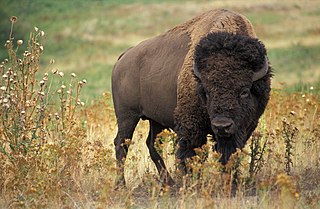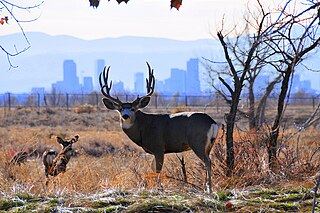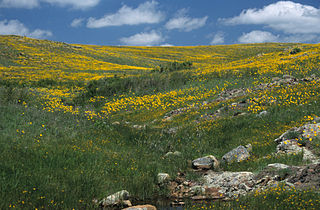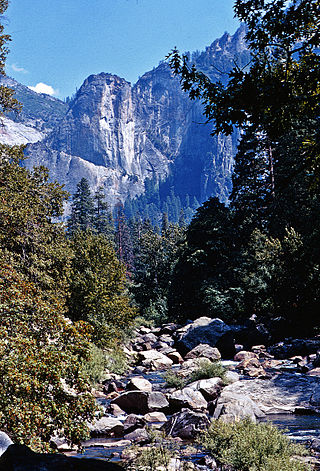Related Research Articles
The conservation movement, also known as nature conservation, is a political, environmental, and social movement that seeks to manage and protect natural resources, including animal, fungus, and plant species as well as their habitat for the future. Conservationists are concerned with leaving the environment in a better state than the condition they found it in. Evidence-based conservation seeks to use high quality scientific evidence to make conservation efforts more effective.

The American bison, commonly known as the American buffalo, or simply buffalo, is a species of bison that is endemic to North America. It is one of two extant species of bison, along with the European bison. Its historical range circa 9000 BC is referred to as the great bison belt, a tract of rich grassland spanning from Alaska south to the Gulf of Mexico, and east to the Atlantic Seaboard, as far north as New York, south to Georgia, and according to some sources, further south to northern Florida, with sightings in North Carolina near Buffalo Ford on the Catawba River as late as 1750.

Elk Island National Park is a national park in Alberta, Canada, that played an important part in the conservation of the plains bison. The park is administered by the Parks Canada Agency. This "island of conservation" is 35 km (22 mi) east of Edmonton, along the Yellowhead Highway, which goes through the park. It is Canada's eighth smallest in area but largest fully enclosed national park, with an area of 194 km2 (75 sq mi).

Madison Grant was an American lawyer, zoologist, anthropologist, and writer known for his work as a conservationist, eugenicist, and advocate of scientific racism. Grant is less noted for his far-reaching achievements in conservation than for his pseudoscientific advocacy of Nordicism, a form of racism which views the "Nordic race" as superior.

Theodore Roosevelt National Park is a national park of the United States in the badlands of western North Dakota comprising three geographically separated areas. This park pays homage to the time that Theodore Roosevelt spent in the surrounding area and in the Dakota Territories before they were states. Roosevelt lived in the area after his mother and wife died hours apart on February 14, 1884. Theodore Roosevelt National Park is the only American national park named directly after a single person.

The Rocky Mountain Arsenal National Wildlife Refuge is a 15,988-acre (24.981 sq mi) National Wildlife Refuge located adjacent to Denver and Commerce City, Colorado, in the United States. It is approximately 8 miles (13 km) northeast of downtown Denver. The refuge is on the grounds of the former Rocky Mountain Arsenal, a United States Army chemical weapons manufacturing facility. The site was designated a national wildlife refuge in 1992 by the United States Congress, and underwent a costly environmental cleanup in order to remove pollutants. The refuge is managed by the United States Fish and Wildlife Service. More than 330 species of wildlife inhabit the refuge, including raptors, deer, raccoons, coyotes, white pelicans, black-footed ferrets, black-tailed prairie dogs, and bison.

Wichita Mountains Wildlife Refuge, located in southwestern Oklahoma near Lawton, has protected unique wildlife habitats since 1901 and is the oldest managed wildlife facility in the United States Fish and Wildlife Service system. The refuge's location in the geologically unique Wichita Mountains and its areas of undisturbed mixed grass prairie make it an important conservation area. The Wichita Mountains are approximately 500 million years old. Measuring about 59,020 acres (238.8 km2), the refuge hosts a great diversity of species: 806 plant species, 240 species of birds, 36 fish, and 64 reptiles and amphibians are present.

George Bird Grinnell was an American anthropologist, historian, naturalist, and writer. Originally specializing in zoology, he became a prominent early conservationist and student of Native American life. Grinnell has been recognized for his influence on public opinion and work on legislation to preserve the American bison. Mount Grinnell in Glacier National Park in Montana is named after him.

The Wildlife Conservation Society (WCS) is a global 501(c)(3) non-governmental organization, headquartered at the Bronx Zoo in New York City, with a mission to save "wildlife and wild places across the globe". Founded in 1895 as the New York Zoölogical Society (NYZS), the global conservation organization is, as of April 2, 2024, led by Interim President and CEO Robb Menzi. WCS manages four New York City wildlife parks in addition to the Bronx Zoo: the Central Park Zoo, New York Aquarium, Prospect Park Zoo, and Queens Zoo. Together, these parks receive 4 million visitors per year. All these facilities are accredited by the Association of Zoos and Aquariums (AZA). WCS has a global program doing conservation work on the ground in more than 50 countries.

William Temple Hornaday, Sc.D. was an American zoologist, conservationist, taxidermist, and author. He served as the first director of the New York Zoological Park, known today as the Bronx Zoo, and he was a pioneer in the early wildlife conservation movement in the United States.

The Boone and Crockett Club is an American nonprofit organization that advocates fair chase hunting in support of habitat conservation. The club is North America's oldest wildlife and habitat conservation organization, founded in the United States in 1887 by Theodore Roosevelt and George Bird Grinnell. The club was named in honor of hunter-heroes of the day, Daniel Boone and Davy Crockett, whom the club's founders viewed as pioneering men who hunted extensively while opening the American frontier, but realized the consequences of overharvesting game. In addition to authoring a famous "fair chase" statement of hunter ethics, the club worked for the expansion and protection of Yellowstone National Park and the establishment of American conservation in general. The club and its members were also responsible for the elimination of commercial market hunting, creation of the National Park and National Forest Services, National Wildlife Refuge system, wildlife reserves, and funding for conservation, all under the umbrella of what is known today as the North American Model of Wildlife Conservation.

Emerson Hough was an American writer best known for writing western stories and historical novels. His early works included Singing Mouse Stories and Story of the Cowboy. He was well known for his 1902 historical novel The Mississippi Bubble. Many of his works have been adapted into films and serial films.

The National Wildlife Refuge System in the United States has a long and distinguished history.

The American Bison Society (ABS) was founded in 1905 by the New York Zoological Society to help save the bison from extinction and raise public awareness about the species by pioneering conservationists and sportsmen including Ernest Harold Baynes, William T. Hornaday, Madison Grant and Theodore Roosevelt.

Forest and Stream was a magazine featuring hunting, fishing, and other outdoor activities in the United States. The magazine was founded in August 1873 by Charles Hallock. When independent publication ceased, in 1930, it was the ninth oldest periodical in print in the U.S.

Conservation in the United States can be traced back to the 19th century with the formation of the first National Park. Conservation generally refers to the act of consciously and efficiently using land and/or its natural resources. This can be in the form of setting aside tracts of land for protection from hunting or urban development, or it can take the form of using less resources such as metal, water, or coal. Usually, this process of conservation occurs through or after legislation on local or national levels is passed.

American Prairie is a prairie-based nature reserve in Central Montana, United States, on a shortgrass prairie ecosystem with migration corridors and native wildlife. This wildlife conservation area is being developed as a private project of the American Prairie Foundation (APF), a non-profit organization. As of 2024, the reserve habitat base covers a total 527,068 acres (213,297 ha). This includes 140,552 deeded acres and 386,516 leased acres from public land. The organization hopes to expand it greatly through a combination of both private and public lands.
The Wolakota Buffalo Range is a nearly 28,000-acre native grassland (11,000 ha) for a bison herd on the Rosebud Indian Reservation in South Dakota, home of the federally recognized Sicangu Oyate – also known as Sicangu Lakota, and the Rosebud Sioux Tribe, a branch of the Lakota people. The Rosebud Economic Development Corporation (REDCO), the economic arm of the Rosebud Sioux Tribe, is managing the land. Established in 2020, the herd will help develop ecological restoration, cultural practices, economic development, food security and public education. Wolakota involves public and private partners coming together in support of native-led efforts. Bison is the correct taxonomic term but buffalo is the common vernacular term. Buffalo continues to hold a lot of cultural significance, particularly for Indigenous people and is commonly used.

The conservation of bison in North America is an ongoing, diverse effort to bring American bison back from the brink of extinction. Plains bison, a subspecies, are a keystone species in the North American Great Plains. Bison are a species of conservation concern in part because they suffered a severe population bottleneck at the end of the 19th century. The near extinction of the species during the 19th century unraveled fundamental ties between bison, grassland ecosystems, and indigenous peoples’ cultures and livelihoods. English speakers used the word buffalo for this animal when they arrived. Bison was used as the scientific term to distinguish them from the true buffalo. Buffalo is commonly used as it continues to hold cultural significance, particularly for Indigenous people.
References
- ↑ Hall, K. (2000). A Nation of States: Federalism at the Bar of the Supreme Court. A Garland series. Garland Pub. p. 402. ISBN 978-0-8153-3429-3 . Retrieved November 19, 2018.
- ↑ Petzal, David (June 2004). "The Test of an Outdoorsman". Field & Stream. Retrieved May 8, 2019.
- ↑ Petzel, David E. (June 2004). Field & Stream. p. 9. Retrieved November 19, 2018.
- 1 2 "Cabin built in Victor heading to New York for prestigious conservation group". KTVH.com. September 4, 2018. Retrieved November 19, 2018.
- ↑ Doherty, Jeffrey (March 22, 2012). "American Conservation and the Expansion of Waterton Lakes Park 1910-1914". Alberta History. Archived from the original on November 19, 2018. Retrieved November 19, 2018.
- ↑ "Camp Fire Conservation Fund - Supporting conservation through education, research, and organization". Camp Fire Conservation Fund. Retrieved October 18, 2023.
- 1 2 3 4 "Camp Fire Club Legacy". Camp Fire Fund. Archived from the original on May 8, 2019. Retrieved May 8, 2019.
- ↑ Been, Frank. "A DISCUSSION OF NATIONAL PARK STANDARDS". NPS.gov. National Park Service.
- ↑ "TR Center - The welcome camp-fire built for Theodore Roosevelt by the Camp-fire club of America". www.theodorerooseveltcenter.org.